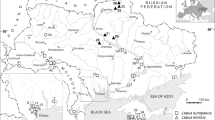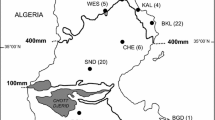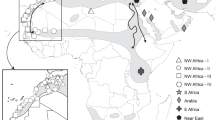Among the European fauna, the Sardinian hare (Lepus sp.) is peculiar in that it differs from all other hares inhabiting the continent. Here, we report on the variation of a 461 bp sequence of hypervariable domain 1 of the mitochondrial control region, examined in 42 hares collected throughout Sardinia and compared to the corresponding sequences of different Lepus taxa. Seventeen novel haplotypes were found in the Sardinian population, resulting in a haplotype diversity of 0.840 and a nucleotide diversity of 0.012. As a result of Bayesian and principal coordinates analyses, Sardinian hares were grouped with North African hares, constituting a monophyletic clade that diverges from all other Old World hares, including Cape hares from South Africa and East Asia. Hence, our data agree that populations inhabiting North Africa and Sardinia form a distinct taxon, which could possibly be included in the L. capensis superspecies. Moreover, two corresponding lineages can be found in Sardinia and Tunisia, providing evidence of a common origin of the two populations and thus supporting the hypothesis that North African hares were introduced into the island in historical times. Our data show that the two lineages differ in their geographic distribution throughout the island and that the wild Sardinian population also shows the signature of a postintroduction demographic expansion.






Similar content being viewed by others
REFERENCES
Alves, P. C., Ferrand, N., Suchentrunk, F., and Harris, D. J. (2003). Ancient introgression of Lepus timidus mtDNA into L. granatensis and L. europaeus in the Iberian Peninsula. Mol. Phylogen. Evol. 27:70–80.
Anderson, M. J. (2003). PCO, a Fortran Computer Program for Principal Coordinate Analysis, Department of Statistics, University of Auckland, New Zealand.
Aris-Brosou, S., and Excoffier, L. (1996). The impact of population expansion and mutation rate heterogeneity on DNA sequence polymorphism. Mol. Biol. Evol. 13:494–504.
Arnason, U., Adegoke, J. A., Bodin, K., Born, E. W., Esa, Y. B., Gullberg, A., Nilsson, M., Short, R. V., Xu, X., and Janke, A. (2002). Mammalian mitogenomic relationships and the root of the eutherian tree. Proc. Natl. Acad. Sci. U.S.A. 99:8151–8156.
Avise, J. C., Arnold, J., Ball, R. M., Bermingham, E., Lamb, T., Neigel, J. E., Reeb, C. A., and Saunders, N. C. (1987). Intraspecific phylogeography: The mitochondrial DNA bridge between population genetics and systematics. Annu. Rev. Ecol. Syst. 18:489–522.
Avise, J. C., Walker, D. E., and Johns, G. C. (1998). Speciation durations and Pleistocene effects on vertebrate phylogeography. Proc. R. Soc. Lond. B 265:1707–1712.
Ben Slimen, H., Suchentrunk, F., Memmi, A., and Ben Ammar Elgaaied, A. (2005). Biochemical genetic relationships among Tunisian hares (Lepus sp.), South African Cape hares (L. capensis), and European brown hares (L. europaeus). Biochem. Genet. 43:577–596.
Ben Slimen, H., Suchentrunk, F., Memmi, A., Sert, H., Kryger, U., Alves, P. C., and Ben Ammar Elgaaied, A. (2006a). Evolutionary relationships among hares from North Africa (Lepus sp. or Lepus spp.), Cape hares (L. capensis) from South Africa, and brown hares (L. europaeus), as inferred from mtDNA PCR-RFLP and allozyme data. J. Zool. Syst. Evol. Res. 44:88–99.
Ben Slimen, H., Suchentrunk, F., Shahin, A. B., and Ben Ammar Elgaaied, A. (2006b). Phylogenetic analysis of mtCR-1 sequences of Tunisian and Egyptian hares (Lepus sp. or spp., Lagomorpha) with different coat colours. Mamm. Biol., in press (DOI: 10.1016/J.MAMBIO.2006.03.002).
Caloi, L., Gliozzi, E., Kotsakis, T., Malatesta, A., and Palombo, M. R. (1986). Observations on the palaeobiogeography of Pleistocene mammals in Italy. Hystrix 1:7–23. [In Italian]
Clement, M., Posada, D., and Crandall, K. A. (2000). TCS, a computer program to estimate gene genealogies. Mol. Ecol. 9:1657–1659.
Corbet, G. B. (1986). Relationships and origins of the European lagomorphs. Mamm. Rev. 16:105–110.
Flux, J. E. C., and Angermann, R. (1990). The hares and jackrabbits. In Chapman, J. A., and Flux, J. E. C. (eds.), Rabbits, Hares and Picas: Status Survey and Conservation Action Plan, IUCN/SSC Lagomorph Specialist Group, Glaud, Seychelles.
Fu, Y.-X. (1997). Statistical tests of neutrality of mutations against population growth, hitchhiking and background selection. Genetics 147:915–925.
Ghigi, A. (1917). Mammals of Italy considered in their relationships with the agriculture. Riv. Sci. Nat.-Nat. 8:125–126. [In Italian]
Goldstein, P. Z., DeSalle, R., Amato, G., and Vogler, A. P. (2000). Conservation genetics at the species boundary. Conserv. Biol. 14:120–131.
Hasegawa, M., Kishino, H., and Yano, T. (1985). Dating of the human-ape splitting by a molecular clock of mitochondrial DNA. J. Mol. Evol. 22:160–174.
Hoffmann, R. S. (1993). Order Lagomorpha. In Wilson, D. E., and Reeder, D. M. (eds.), Mammal Species of the World: A Taxonomic and Geographic Reference, 2nd edn., Smithsonian Institution Press, Washington, pp. 807–827.
Kasapidis, P., Suchentrunk, F., Magoulas, A., and Kotulas, G. (2005). The shaping of mitochondrial DNA phylogeographic patterns of the brown hare (Lepus europaeus) under the combined influence of Late Pleistocene climatic fluctuations and anthropogenic translocations. Mol. Phylogen. Evol. 34:55–66.
Kryger, U., Robinson, T. J., and Bloomer, P. (2004). Population structure and history of southern African scrub hares, Lepus saxatilis. J. Zool. 263:121–123.
Kumar, S., Tamura, K., and Nei, M. (2004). MEGA3: Integrated software for Molecular Evolutionary Genetic Analysis and sequence alignment. Brief. Bioinform. 5:150–163.
Luchetti, S., Sacchi, O., Meriggi, A., and Apollonio, M. (2005). Habitat requirements of Mediterranean hare (Lepus capensis mediterraneus) in protected areas of Sardinia. In Proceedings of the 27th Congress of the International Union of Game Biologist (IUGB), Hannover, Germany, August 28–September 3.
Melo-Ferreira, J., Boursot, P., Suchentrunk, F., Ferrand, N., and Alves, P. C. (2005). Invasion from the cold past: Extensive introgression of mountain hare (Lepus timidus) mitochondrial DNA into three other hare species in northern Iberia. Mol. Ecol. 14:2459–2464.
Meyer, S., Weiss, G., and von Häseler, A. (1999). Pattern of nucleotide substitution and rate heterogeneity in the hypervariable regions I and II of human mtDNA. Genetics 152:1103–1110.
Mitchell-Jones, A. J., Amori, G., Bogdanowicz, W., Krystufek, B., Reijnders, P. J. H., Spitzenberger, F., Stubbe, M., Thissen, J. B. M., Vohralik, V., and Zima, J. (1999). The Atlas of European Mammals, Academic, London.
Nei, M., and Kumar, S. (2000). Molecular Evolution and Phylogenetics, Oxford University Press, New York.
Palacios, F. (1998). Diversity of hares in Europe. In Reig, S. (ed.), Euro-American Mammal Congress, Abstracts, Universidad de Santiago de Compostela, Spain, July 19–24, p. 85.
Petter, F. (1959). Eléments d’une révision des lièvres africains du sous-genre Lepus. Mammalia 23:41–67.
Petter, F. (1961). Eléments d’une révision des lièvres européens et asiatique du sous-genre Lepus. Z. Säugetierkunde 26:30–40.
Pierpaoli, M., Riga, F., Trocchi, V., and Randi, E. (1999). Species extinction and evolutionary relationships of the Italian hare (Lepus corsicanus) as described by mitochondrial DNA sequencing. Mol. Ecol. 8:1805–1817.
Posada, D., and Crandall, K. A. (1998). ModelTest: Testing the model of DNA substitution. Bioinformatics 14:817–818.
Rogers, A. R., and Harpending, H. C. (1992). Population growth makes waves in the distribution of pairwise genetic differences. Mol. Biol. Evol. 9:552–569.
Ronquist, F., and Huelsenbeck J. P. (2003). MrBayes 3: Bayesian phylogenetic inference under mixed models. Bioinformatics 19:1572–1574.
Rozas, J., Sànchez-Del Barrio, J. C., Messeguer, X., and Rozas, R. (2003). DNASP: DNA polymorphism analyses by coalescent and other methods. Bioinformatics 19:2496–2497.
Spagnesi, M. (2002). Lepre sarda. In Spagnesi, M., and De Marinis, A. M. (eds.), Mammiferi d’Italia. Quaderni Conservazione della Natura, vol. 14, Min. Ambiente-1st. Naz. Fauna Selvatica, pp. 152–153. [In Italian]
Suchentrunk, F., Ben Slimen, H., and Sert, H. (2006a). On nuclear gene pools and mtDNA characteristics of South African Cape hares (Lepus capensis), scrub hares (L. saxatilis) and European brown hares (L. europaeus): Phylogenetic implications. In Alves, P. C., Ferrand, N., and Hackländer, K. (eds.), Lagomorph Biology: Evolution, Ecology, and Conservation, Springer-Verlag, Heidelberg, Germany.
Suchentrunk, F., Ben Slimen, H., Stamatis, C., Sert, H., Scandura, M., Apollonio, M., and Mamuris Z. (2006b). Molecular approaches revealing prehistoric, historic, or recent translocations and introductions of hares (genus Lepus) by humans. Hum. Evol. 21:151–165.
Suchentrunk, F., Jaschke, C., and Haiden, A. (2001). Little allozyme and mtDNA variability in brown hares (Lepus europaeus) from New Zealand and Britain: A legacy of bottlenecks? Mamm. Biol. 66:48–59.
Suchentrunk, F., Mamuris, Z., Stamatis, C., Ben Slimen, H., Hacklander, K., Härer, G., and Giacometti, M. (2004). Bilateral introgressive hybridization in wild living mountain hares (L. timidus varronis) and brown hares (L. europaeus) from Switzerland. 2nd World Lagomorph Conference, July 26–31, Vairão, Portugal, p. 26.
Swofford, D. L. (2000). PAUP * : Phylogenetic Analysis Using Parsimony (* and Other Methods). Version 4.0 beta, Sinauer Associates, Sunderland, MA.
Tajima, F. (1989). Statistical method for testing the neutral mutation hypothesis by DNA polymorphism. Genetics 123:585–595.
Tajima, F. (1996). The amount of DNA polymorphism maintained in a finite population when the neutral mutation rate varies among sites. Genetics 143:1457–1465.
Templeton, A. R., Crandall, K. A., and Sing, C. F. (1992). A cladistic analysis of phenotypic associations with haplotypes inferred from restriction endonuclease mapping and DNA sequence data, 3: Cladogram estimation. Genetics 132:619–633.
Thompson, J. D., Higgins, D. G., and Gibson, T. J. (1994). Clustal W, improving the sensitivity of progressive multiple sequence alignment through sequence weighting, position-specific gap penalties and weight matrix choice. Nucleic Acids Res. 22:4673–4680.
Thulin, C. G., Jaarola, M., and Tegelström, H. (1997). The occurrence of mountain hare mitochondrial DNA in wild brown hares. Mol. Ecol. 6:463–467.
Thulin, C. G., and Tegelström, H. (2002). Biased geographical distribution of mitochondrial DNA that passed the species barrier from mountain hares to brown hares (genus Lepus): An effect of genetic incompatibility and mating behaviour? J. Zool. 258:299–306.
Trocchi, V., Riga, F., and Randi, E. (2003). Lepus (“capensis”) mediterraneus Wagner, 1841: Sardischer Hase. In Niethammer, J., and Krapp, F. (eds.), Handbuch der Säugetiere Europas: Lagomorpha, Vol. 3, AULA-Verlag, Wiesbaden, Germany, pp. 105–116.
Vigne, J. D. (1992). Zooarchaeology and the biogeographical history of the mammals of Corsica and Sardinia since the last ice age. Mamm. Rev. 22:87–89.
Waltari, E., Demboski, J. R., Klein, D. R., and Cook, J. A. (2004). A molecular perspective on the historical biogeography of the northern high latitudes. J. Mamm. 85:591–600.
Wilkens, B. (2003). Sardinia, Corsica et Baleares Antiquae. Int. J. Archaeol. 1:181–197.
ACKNOWLEDGMENTS
This research was supported by a grant of the Sardinian Regional Government, Ministry of Environment. We thank R. Foddai for his help in laboratory analyses and Mr. G. Cau for allowing us to collect hare samples from the breeding station of Las Plassas. We are also indebted to S. Luchetti, S. Contu, S. Luccarini, A. Pintore, A. Pipia, M. F. Di Benedetto, M. Fois, M. Masala, M. Derudas, and several local hunters for their help in collecting samples throughout Sardinia. We are finally grateful to B. Wilkens, who provided us with zooarchaeological information, and to the journal editor and to an anonymous reviewer for their constructive comments.
Author information
Authors and Affiliations
Corresponding author
Rights and permissions
About this article
Cite this article
Scandura, M., Iacolina, L., Slimen, H.B. et al. Mitochondrial CR-1 Variation in Sardinian Hares and Its Relationships with Other Old World Hares (Genus Lepus). Biochem Genet 45, 305–323 (2007). https://doi.org/10.1007/s10528-007-9076-z
Received:
Accepted:
Published:
Issue Date:
DOI: https://doi.org/10.1007/s10528-007-9076-z




